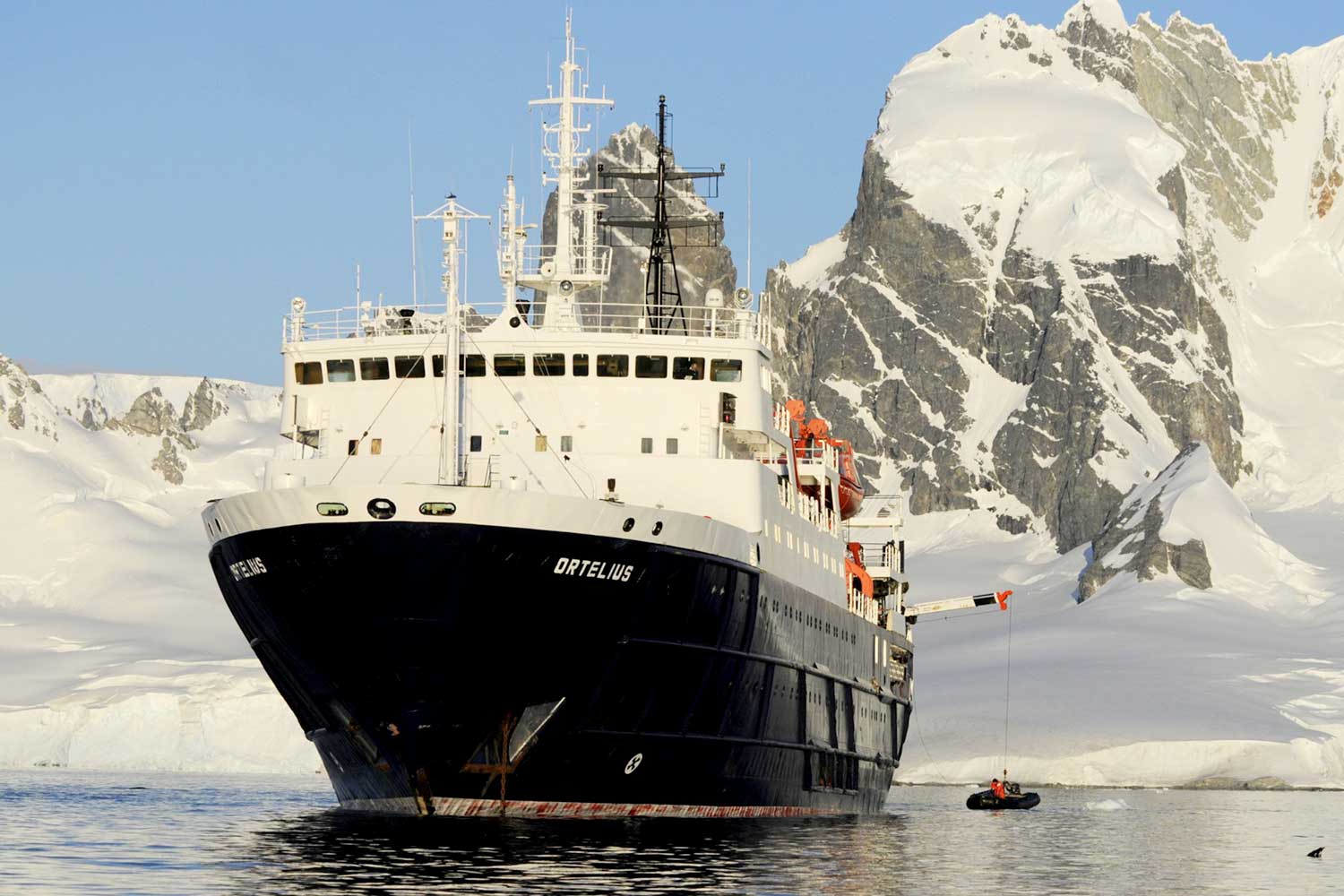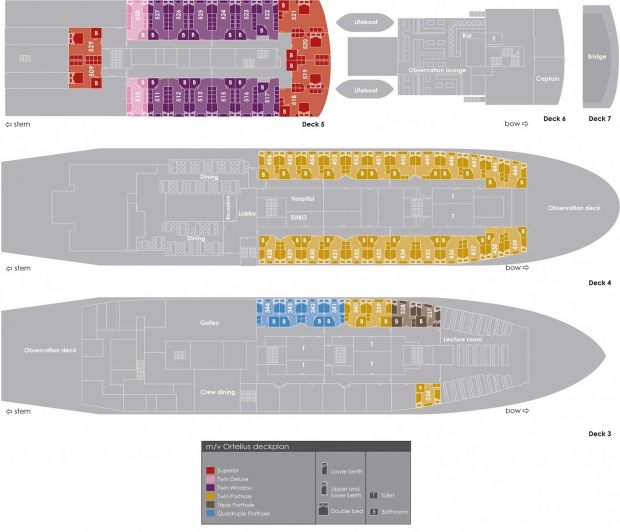Remote Weddell Sea Explorer: Ortelius
Antarctica's Weddell Sea
Be on the trail of famed polar explorer Ernest Shackleton and his ship Endurance, experiencing South Georgia, then the Weddell Sea’s amazing wildlife and tabular icebergs before returning via Elephant Island. The continental borders of the Weddell Sea are formed by huge floating sheets of ice, which produce abundant, massive tabular icebergs and ice formations with unique photo opportunities. Zodiac cruises, ice landings and helicopter excursions are features of this truly unique expedition, if conditions allow
- Explore the Weddell Sea pack ice
- Helicopter landings and sightseeing
- Massive tabular icebergs
- South Georgia
- Remote and volcanic South Sandwich Islands
- Rarely visited landing sites of East Antarctica - Neuschwabenland, Vahsel Bay, Larsen Ice Shelf
- Paulet and Devil Islands, Legendary Elephant Island
The continental borders of the Weddell Sea are formed by huge floating sheets of ice. Scientists have declared the waters of the Weddell Sea to be the clearest water of any sea on Earth. The Weddell Sea is home to a large number of orcas, humpbacks, and minke whales as well as leopard, Weddell, and crabeater seals. Several penguin species can be seen there too. On the ship, our structured educational program will complement other activities. You will have the opportunity to attend several lectures on a variety of topics, such as wildlife, landscape, history, and more. We actively participate in citizen science projects, and you can also participate in such projects.
Helicopter transfers:
Wherever possible, you will be transferred to shore using Zodiacs. On this voyage the ship will also operate our helicopters in sites where Zodiacs cannot be used. If local conditions allow for helicopter transfers, we will attempt landings both on land and sea ice. We cannot, however, guarantee any set amount of helicopter time. While helicopters provide an advantage in reaching otherwise inaccessible areas, the final itinerary is determined by local weather, ice, and other conditions that may change rapidly and impact our ability to use helicopters. Please understand and accept this. Safety is our top concern, and no compromises can be made. The vessel is equipped with three helicopters. One helicopter always needs to be supported by a second functioning helicopter. Please again note that no guarantees to their use can be given, and no claims will be accepted in any event.
Stewart's Take
Explores one of the least-visited areas on Earth, Antarctica’s amazing Weddell Sea.
Overview
Be on the trail of famed polar explorer Ernest Shackleton and his ship Endurance, experiencing South Georgia, then the Weddell Sea’s amazing wildlife and tabular icebergs before returning via Elephant Island. The continental borders of the Weddell Sea are formed by huge floating sheets of ice, which produce abundant, massive tabular icebergs and ice formations with unique photo opportunities. Zodiac cruises, ice landings and helicopter excursions are features of this truly unique expedition, if conditions allow.Scrolling is disabled on map, please click to enable.
Expedition Vessel: M/V Ortelius

The ice-strengthened vessel Ortelius is an excellent vessel for Polar expedition cruises in the Arctic and Antarctica, providing possibilities to adventure in remote locations such as the Ross Sea and Franz Josef Land. Ortelius was built in Gdynia, Poland in 1989, was named Marina Svetaeva, and served as a special purpose vessel for the Russian Academy of Science. The vessel is now re-flagged and renamed Ortelius. She offers a comfortable hotel standard, with two restaurants, a bar/lecture room and a sauna. Her voyages are primarily developed to offer our passengers a quality exploratory wildlife program, trying to spend as much time ashore as possible. As the number of passengers is limited to approximately 106, flexibility assures maximum wildlife opportunities.

- Voyage as indicated in the itinerary.
- All meals throughout the voyage aboard the ship including snacks, coffee and tea.
- Free use of rubber boots and snowshoes.
- Pre-scheduled group transfer from the vessel to the airport in Ushuaia (directly after disembarkation).
- All shore excursions and activities throughout the voyage by Zodiac.
- Program of lectures by noted naturalists and leadership by experienced expedition staff.
- All miscellaneous service taxes and port charges throughout the program.
- Comprehensive pre-departure material.
- Any airfare whether on scheduled or charter flights.
- Pre- and post land arrangements.
- Transfers to the vessel.
- Passport and visa expenses.
- Government arrival and departure taxes.
- Meals ashore.
- Baggage, cancellation and personal insurance (which is strongly recommended).
- Excess baggage charges.
- All items of a personal nature such as laundry, bar, beverage charges and telecommunication charges.
- The customary gratuity at the end of the voyages for stewards and other service personnel aboard (guidelines will be provided).

Tour Dossier
Remote Weddell Sea Explorer: Ortelius

A rare and incredible expedition to South Georgia, South Sandwich Islands - Neuschwabenland, Vahsel Bay, Larsen Ice Shelf, Paulet & Devil, Elephant Is
File Creation date: 2024-04-19 - for updated information and dates and prices see the following page:
http://expeditionsonline.com/tour/remote-weddell-sea-explorer-ortelius_429

Remote Weddell Sea Explorer: Ortelius
Duration: 28 days
Location: Antarctica's Weddell Sea
Available: February-March
Start: Ushuaia, Argentina
Finish: Ushuaia, Argentina

Highlights
- Explore the Weddell Sea pack ice
- Helicopter landings and sightseeing
- Massive tabular icebergs
- South Georgia
- Remote and volcanic South Sandwich Islands
- Rarely visited landing sites of East Antarctica - Neuschwabenland, Vahsel Bay, Larsen Ice Shelf
- Paulet and Devil Islands, Legendary Elephant Island

Itinerary
Be on the trail of famed polar explorer Ernest Shackleton and his ship Endurance, experiencing South Georgia, then the Weddell Sea’s amazing wildlife and tabular icebergs before returning via Elephant Island. The continental borders of the Weddell Sea are formed by huge floating sheets of ice, which produce abundant, massive tabular icebergs and ice formations with unique photo opportunities. Zodiac cruises, ice landings and helicopter excursions are features of this truly unique expedition, if conditions allow





Ship Information
Expedition Vessel: M/V Ortelius

The ice-strengthened vessel Ortelius is an excellent vessel for Polar expedition cruises in the Arctic and Antarctica, providing possibilities to adventure in remote locations such as the Ross Sea and Franz Josef Land. Ortelius was built in Gdynia, Poland in 1989, was named Marina Svetaeva, and served as a special purpose vessel for the Russian Academy of Science. The vessel is now re-flagged and renamed Ortelius. She offers a comfortable hotel standard, with two restaurants, a bar/lecture room and a sauna. Her voyages are primarily developed to offer our passengers a quality exploratory wildlife program, trying to spend as much time ashore as possible. As the number of passengers is limited to approximately 106, flexibility assures maximum wildlife opportunities.

Remote Weddell Sea Explorer: Ortelius
For the latest, up-to-date departure dates and prices please refer to the tour page:
http://expeditionsonline.com/tour/remote-weddell-sea-explorer-ortelius_429
Included
- Voyage as indicated in the itinerary.
- All meals throughout the voyage aboard the ship including snacks, coffee and tea.
- Free use of rubber boots and snowshoes.
- Pre-scheduled group transfer from the vessel to the airport in Ushuaia (directly after disembarkation).
- All shore excursions and activities throughout the voyage by Zodiac.
- Program of lectures by noted naturalists and leadership by experienced expedition staff.
- All miscellaneous service taxes and port charges throughout the program.
- Comprehensive pre-departure material.
Excluded
- Any airfare whether on scheduled or charter flights.
- Pre- and post land arrangements.
- Transfers to the vessel.
- Passport and visa expenses.
- Government arrival and departure taxes.
- Meals ashore.
- Baggage, cancellation and personal insurance (which is strongly recommended).
- Excess baggage charges.
- All items of a personal nature such as laundry, bar, beverage charges and telecommunication charges.
- The customary gratuity at the end of the voyages for stewards and other service personnel aboard (guidelines will be provided).
General Terms and Conditions
Expeditions Online Newsletter
Sign up to be an Expeditions Online insider and receive info on exclusive deals, discounts and more!